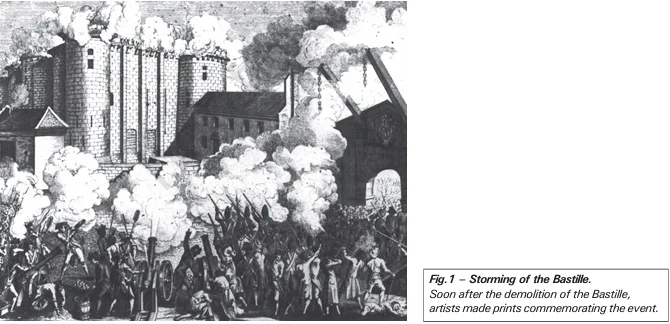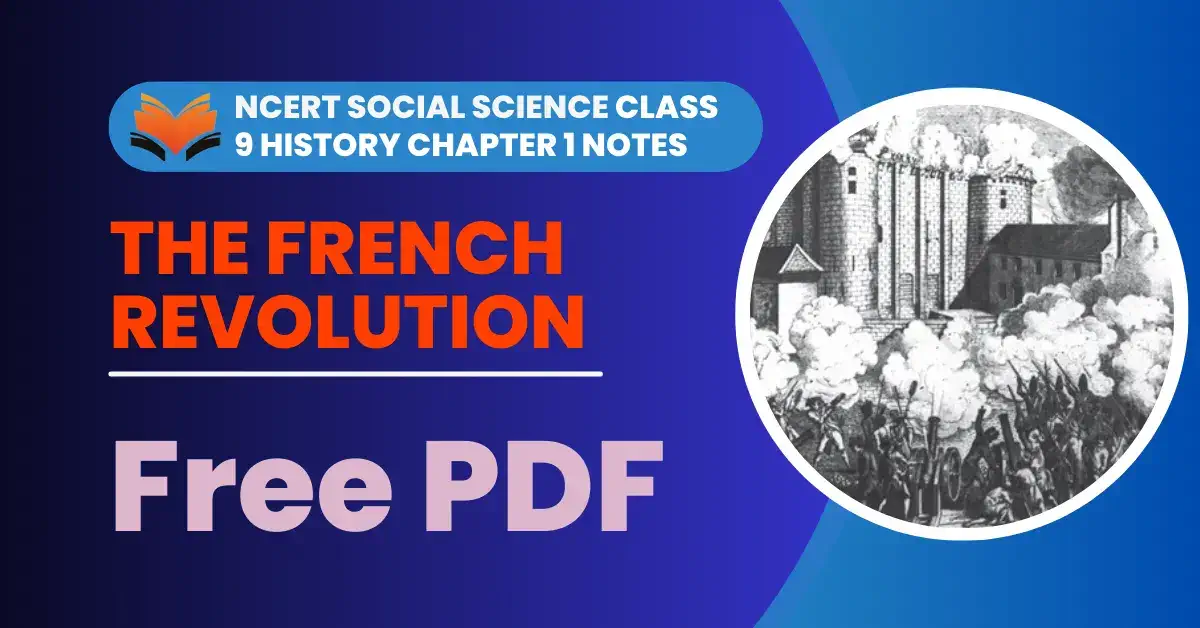NCERT Social Science Class 9 History Chapter 1 Notes: The French Revolution Free PDF
Topic Covered in Class 9 History Chapter 1 Notes: French society during the late eighteenth century, the outbreak of the revolution, France abolishes monarchy and becomes a republic, did women have a revolution, the abolition of slavery, the revolution and everyday life.
The NCERT Social Science Class 9 History Chapter 1 Notes: The French Revolution Free PDF simplifies a heavy chapter so you can revise fast and remember more. It breaks down tricky causes with real examples – the crushing taxes on the Third Estate, food shortages after bad harvests, and how Enlightenment thinkers challenged absolute monarchy. You’ll see the Bastille not just as a date to memorize, but as a turning point that signaled the collapse of royal authority.
What you get: clean timelines, quick-glance summaries, a diagram of the Estate system, and exam-style questions that mirror how teachers frame tests. Tough ideas – like the Declaration of the Rights of Man, the Constitution of 1791, and the rise of the Jacobins – are explained in short, memorable points so you can revise quickly without missing key concepts. Use it alongside your textbook if you’re working through NCERT history notes class 9. If you prefer downloading class 9 history chapter 1 notes, we’ve kept the class 9 SST history chapter 1 PDF light and easy to learn history NCERT.
Need last-minute prep? The “history class 9 chapter 1 notes pdf” highlights causes, events, and consequences in one page. Prefer deeper dives? Each section links key terms to why they mattered – citizenship, sovereignty, equality before law.
Grab the French Revolution class 9 notes pdf for free download, study smart, and walk into class 9 SST history chapter 1 prepared.
Download Free PDF Notes for NCERT Class 9 History Chapter 1 Notes – The French Revolution
NCERT Social Science Class 9 History Chapter 1 Notes_ The French Revolution Free PDF Notes and MCQ’s
Struggling to keep the French Revolution straight in your head? You’re not alone. This free guide for NCERT Class 9 History Chapter 1 turns a crowded chapter into clear, bite-sized ideas you can actually remember. We walk you through the unfair tax burden on the Third Estate, why the Bastille mattered, and what the Declaration of the Rights of Man really changed – without drowning you in jargon. Pair these notes with your textbook from CBSE NCERT books class 9 for quick, point-wise revision. You’ll get clean timelines, cause – effect maps, and mini practice questions so you can test yourself as you go. Prefer reading on your phone? Grab the history class 9 chapter 1 notes pdf and skim anywhere.
If you’ve been hunting for solid class 9 French revolution notes, this is it. It works whether you call it class 9 history Ch 1 notes or class 9th history chapter 1 notes – the focus is the same: understand the story, remember the reasons, and write sharper answers. Everything aligns with NCERT class 9 history chapter 1 and fits neatly into your broader class 9th SST notes. Stop memorizing disconnected facts. Download the PDF, follow the flow, and walk into your exam confident about causes, events, and consequences.
The French Revolution

1. Storming of the Bastille (14 July 1789):
- Date & Place: On the morning of 14 July 1789, Paris was in a state of alarm.
- Cause of Alarm: The king had ordered troops into Paris, and rumours spread that the army would open fire on citizens.
- Formation of People’s Militia: About 7,000 men and women gathered at the town hall and decided to form a people’s militia.
- Search for Arms: They broke into government buildings to look for weapons.
- March to the Bastille: Several hundred people marched towards the Bastille fortress-prison in the eastern part of Paris.
- Reason to Target Bastille: They hoped to find hoarded ammunition inside.
- Armed Fight: A violent clash followed. The commander of the Bastille was killed, and the prisoners were released (only seven prisoners).
- Symbol of Despotism: The Bastille was hated because it symbolized the despotic power of the king.
- Demolition: The fortress was demolished, and its stone fragments were sold in markets as souvenirs of its destruction.
- Spread of Riots: The following days saw riots across Paris and the countryside, mostly against the high price of bread.
- Historical Significance: Historians later saw 14 July 1789 as the beginning of the French Revolution, which eventually led to the execution of the king.
- Contemporary View: At the time, most people did not anticipate that these events would end in the king’s execution.
Next & Previous Covered Topic Wise Class 9 History Chapter 1 Notes: The French Revolution Class 9
MCQs on NCERT Class 9 History Chapter 1 Topic – The French Revolution
Here are the top exam-oriented MCQ-type questions on “The French Revolution” that you should prepare for your CBSE or state board exams:
Question 1. On which date was the Bastille stormed in Paris?
a) 5 May 1789
b) 14 July 1789
c) 4 August 1789
d) 21 January 1793
Answer: b) 14 July 1789
Question 2. Why was Paris in a state of alarm on 14 July 1789?
a) The king had fled the city
b) The army was marching in protest
c) The king had commanded troops to move into the city
d) The Bastille had been set on fire
Answer: c) The king had commanded troops to move into the city
Question 3. What rumour spread among citizens of Paris on 14 July 1789?
a) The Bastille had been demolished
b) The king would soon leave the throne
c) The king would soon order the army to open fire upon the citizens
d) The National Assembly would be dissolved
Answer: c) The king would soon order the army to open fire upon the citizens
Question 4. About how many men and women gathered in front of the town hall on 14 July 1789?
a) 2,000
b) 5,000
c) 7,000
d) 10,000
Answer: c) 7,000
Question 5. What decision did the crowd take when they assembled in front of the town hall?
a) To march to Versailles
b) To form a people’s militia
c) To meet the king directly
d) To surrender peacefully
Answer: b) To form a people’s militia
Question 6. Why did the citizens break into several government buildings on 14 July 1789?
a) To destroy them as a protest
b) To search for arms
c) To free political leaders
d) To hoist the revolutionary flag
Answer: b) To search for arms
Question 7. The fortress-prison Bastille was located in which part of Paris?
a) Western part
b) Northern part
c) Eastern part
d) Southern part
Answer: c) Eastern part
Question 8. Why did the people march towards the Bastille?
a) To destroy the prison walls
b) To find hoarded ammunition
c) To release thousands of prisoners
d) To arrest the commander
Answer: b) To find hoarded ammunition
Question 9. What happened to the commander of the Bastille during the armed fight?
a) He escaped
b) He surrendered
c) He was killed
d) He joined the revolutionaries
Answer: c) He was killed
Question 10. How many prisoners were released after the Bastille was stormed?
a) 5
b) 7
c) 9
d) 12
Answer: b) 7
Question 11. Why was the Bastille hated by the people of France?
a) It was a symbol of wealth
b) It was a symbol of equality
c) It stood for the despotic power of the king
d) It belonged to the clergy
Answer: c) It stood for the despotic power of the king
Question 12. What happened to the Bastille after it was captured?
a) It was converted into a museum
b) It was demolished
c) It was rebuilt by the king
d) It was left abandoned
Answer: b) It was demolished
Question 13. What was done with the stone fragments of the Bastille?
a) Used for building roads
b) Thrown into the river Seine
c) Sold in the markets as souvenirs
d) Sent to Versailles
Answer: c) Sold in the markets as souvenirs
Question 14. What issue led to rioting in Paris and the countryside after the fall of the Bastille?
a) Lack of arms
b) High price of bread
c) Closure of markets
d) Arrest of leaders
Answer: b) High price of bread
Question 15. Much later, how did historians interpret the storming of the Bastille?
a) As an isolated event
b) As the end of monarchy
c) As the beginning of a chain of events that led to the execution of the king
d) As a struggle only for bread
Answer: c) As the beginning of a chain of events that led to the execution of the king
Question 16. What outcome was not anticipated by most people at the time of the Bastille’s fall?
a) The fall of the monarchy
b) The execution of the king
c) The rise of Napoleon
d) The drafting of a constitution
Answer: b) The execution of the king
Next CBSE/NCERT Class 9 History Chapter Wise Notes & Free PDF
| Chapters No. | Chapters Name |
|---|---|
| Chapter 1 | The French Revolution |
| Chapter 2 | Socialism in Europe and the Russian Revolution |
| Chapter 3 | Nazism and the Rise of Hitler |
| Chapter 4 | Forest Society and Colonialism |
| Chapter 5 | Pastoralists in the Modern World |
Frequently Asked Questions (FAQs)
Question 1. Where can I get class 9th history chapter 1 notes for quick revision?
Answer: You can download the class 9th history chapter 1 notes right here. These history notes boil the chapter down to easy timelines, short definitions, and exam-style questions – perfect when you’re short on time and need a quick, reliable recap.
Question 2. Is there a history class 9 chapter 1 notes pdf I can use on my phone?
Answer: Yes – there’s a lightweight PDF on “the French revolution class 9 notes pdf for free download” designed for phones and laptops. Tip: open it on your phone while commuting and mark the one-page “last-minute checklist” so you can glance over key dates before class.
Question 3. What exactly do the class 9 French Revolution notes cover?
Answer: The summary covers French society before 1789, causes of the revolt (like unfair taxes and bad harvests), the Bastille, the National Assembly’s reforms, and the aftermath. A common mistake: students memorize dates but miss cause-effect links – our notes highlight those links clearly.
Question 4. Will these notes match what I study in CBSE NCERT books class 9?
Answer: Yes – we’ve kept the content in step with the NCERT textbook, but in a shorter, more exam-friendly format. Use both together: read the textbook for depth, use the notes to revise fast.
Question 5. How can I use the notes to prepare for board-style questions?
Answer: Try the mini practice prompts after each section. They’re modelled on typical questions and help you convert one-line facts into 3 – 4 sentence answers – exactly what examiners want.
Question 6. I get confused about the role of women and the revolution. Does the guide help?
Answer: Absolutely. There’s a focused subsection that explains why women protested, what they achieved, and what they didn’t – with one example that helps you remember the difference between political change and everyday life changes.
Question 7. Are these notes enough for last-minute revision?
Answer: Yes – the “the French revolution class 9 pdf” summarizes causes, key events, and consequences on one page. It’s not a substitute for studying earlier, but it’s ideal the day before the test.
Question 8. I’m still nervous about the exam – why should I use these notes?
Answer: We know this chapter can be detail-heavy. These notes simplify the story, point out common pitfalls, and give practice questions so you can revise efficiently and walk into the exam more confident.

